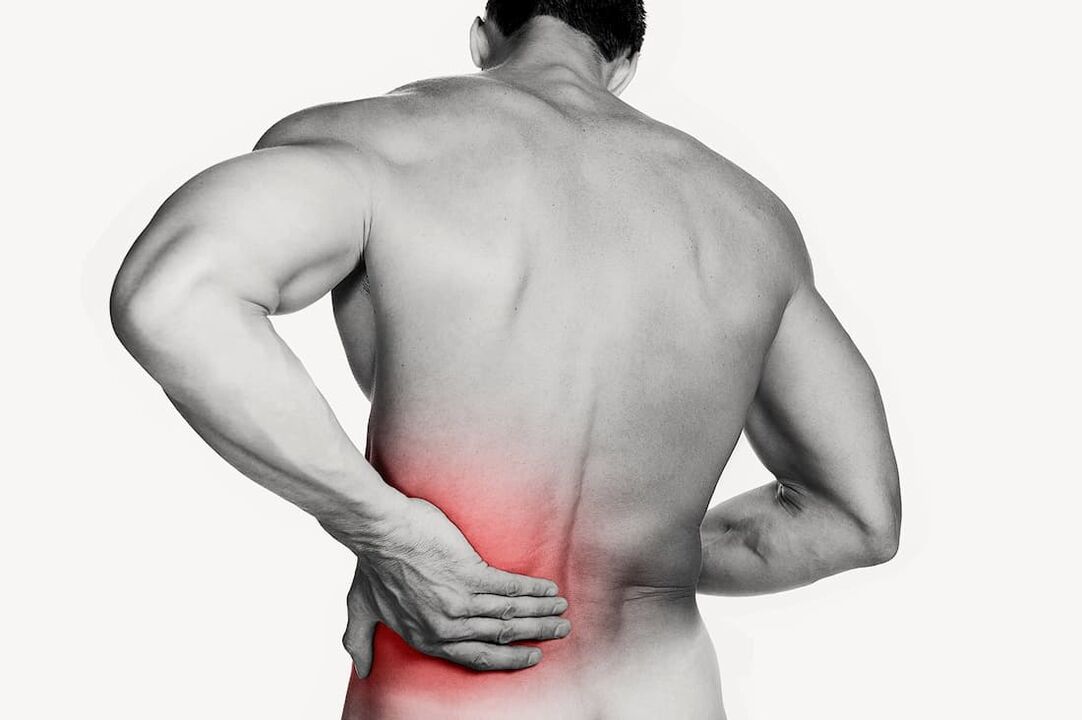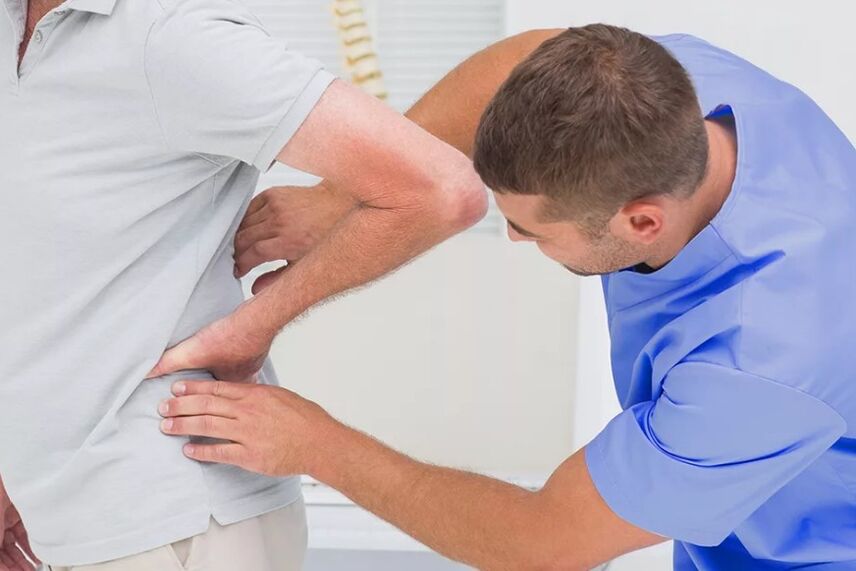
Low pain is the symptom that is rarely paid.Most people associate it with a sitting position, lifting weights or osteochondrosis and in no hurry to see a doctor.In fact, this condition can signal diseases of the kidneys, liver or intestines and problems with the musculoskeletal system will not pass by themselves.Just a timely examination of a specialist and full examination will help identify the cause of the pain and choose the right treatment.
General information
The lower back is an area that experiences a significant load because it is upright.The spine is represented by five large vertebrae, which is further enhanced by the muscle frame.9 out of 10 cases of pain in this area are provoked precisely by the pathology of the musculoskeletal system: osteochondrosis, muscle spasm, hernia of the intervertebral disc, pinching the nerve root.
The remaining 10% of cases are related to diseases of the internal organs located in the projection of the lower back: kidneys, genilory system, intestines, liver.Even a doctor, when examining, cannot always determine the cause of the pain, which is why this condition requires a thorough laboratory and instrumental diagnosis.
Pain
The first thing the doctor asks is the nature of the sensations.Depending on the cause that caused it, the pain in the lower back may be:
- Acute: usually occurs abruptly, characterized by high intensity;The duration of the sensations is no more than 1.5 months;
- Subacute: lasts 6-12 weeks;
- Chronic: sensations of any intensity that lasts 12 weeks or more;
- Transfer (variable): occurs periodically;
- pain;
- dumb;
- Strong, medium intensity, weak.
This division is conditional.Depending on the situation and circumstances, the nature and duration of the sensations, they can vary.It is important to describe them as fully as possible.
Reasons
The reasons why the back begins to hurt in the lower back.Most often provoking factors serve:
- hypothermia;
- lifting weights;
- uneven load distribution (against the background of pregnancy, posture disorders, pathology of the musculoskeletal system);
- infectious lesion;
- diseases of the musculoskeletal system;
- inflammatory processes, including autoimmune;
- Long stay in uncomfortable position;
- change in bone tissue composition (osteoporosis);
- Volume processes: benign and malignant tumors, abscesses;
- hormonal changes (menstruation, pregnancy, menopause);
- kidney disease (urolithiasis, pyelonephritis, glomerulonephritis, abscesses);
- pathology of the gastrointestinal tract;
- Diseases of the uterus and appendages in women, prostate in men, etc.
Illness
Low pain can be a symptom of various diseases of the musculoskeletal system and internal organs.The main task of the doctor is to understand exactly what caused the deterioration and to take the necessary measures.
Here are pathologies that are most common.
Spondylitis
It is a systemic inflammatory disease that causes separate vertebrae in one conglomerate.At the same time, calcium deposition in ligaments stabilizes the spine, resulting in the affected area almost completely loses mobility.
The distinctive characteristics of lower back pain with ankylosing spondylitis include:
- Increasing the intensity at rest, especially with prolonged horizontal recruitment;
- restriction of movements in the lumbar region;
Osteochondrosis of the lumbar spine
This is a very common disease in which periodic discs are smaller, acting as shock absorbers.As a result, the nerve roots and spasms of the surrounding muscles causing severe pain are irritated.In the late stage of the disease, the hernia is formed on the intervertebral disc, which can pressed the spinal cord, enhancing the pain.
With osteochondrosis, the pain intensifies:
- when lifted from a stuck or horizontal position;
- When trying to lie on your stomach;
- With inclinations.
If the disease causes the formation of massive hernia, the pain in the lower back is often accompanied by numbness and the weakness of one or both legs.
Spine curvature in the lumbar region (kyphosis, scoliosis)
Pain in this pathology occurs in the middle and late stages of the development of the disease.The discomfort usually occurs by the end of the day and is often accompanied by fatigue of the spinal muscles.The pain is caused more frequent by spasms of the spinal muscles and it is also possible to examine the muscles when removed (gluteal, periodimal muscles of the upper and lower limbs).
Spondylarthrosis
It is a degenerative-dystrophic cartilage disease covering intervertebral discs.It is gradually smaller and more destroyed, the bones of osteophytes) appear around the lesion area.As a result of a decrease in the distance between the vertebrae, the spinal canal narrow, the nerve roots and the spinal cord are irritated.
Pain with this pathology:
- increases after loading (long -term upright stay, walking) and passes after rest;
- accompanied by the stiffness of movements, first in the morning, then constantly;
- It can be given to the thigh and the hip area.
The muscles in the area of the lesion are spasmodic and constantly in tension, which also enhances pain.
Uroline
The attack of urolithiasis is characterized by severe lumbar pain from the affected kidney.At the same time, the sensations do not change depending on the posture, one cannot find a position in which at least a little weight loss is.The attack is often accompanied by a decrease in the amount of urine and a change in its color to the reddish.
Low pain can also be a consequence:
- Algomenor (painful menstruation);
- pregnancy;
- Pancreatic inflammation;
- osteomyelitis;
- intestinal obstruction;
- appendicitis, etc.
Pain in different parts of the back
Localization of pain can say a lot about their cause.The pain in the upper part of the lumbar region can be a consequence:
- diseases of the spine;
- Injuries;
- muscle spasm against the background of their surge;
- cardiovascular diseases;
- tumors;
- Diseases of the gastrointestinal tract.
If the epicenter is located at the bottom of the lower back, the list of likely causes includes, in addition to diseases of the spine:
- Renal pathology (pyelonephritis, urolithiasis);
- intestinal disorders (constipation, flatulence);
- spasms or inflammatory process in the pelvic organs (salpingophoritis, endometritis);
- More special physiological causes of pregnancy;
- Pressing the sciatic nerve.
Pain skill on the right or left may indicate the lesion of the spinal cord of the spinal cord, the kidneys.
Diagnostics
The diagnosis of lower back pain requires a comprehensive examination.The first stage of search for the cause is the study.The doctor clarifies:
- Localization of pain;
- its character and duration;
- Causes that cause attack or increase pain;
- Circumstances in which the condition improves (a certain posture, immobility, medication, etc.).
Data on injuries and diseases already identified chronic pathologies are collected without failure.The additional possible diagnostic search at the doctor's discretion includes:
- General blood and urine test: helps to identify the inflammatory process in the body, pathology of the kidneys;
- Biochemical blood test to identify signs of kidney damage, pancreas, liver and gallbladder, etc.;
- Ultrasound of the abdominal organs and pelvis, in men - ultrasound of the prostate gland;
- Ultrasound of the kidneys;
- Radiography, CT or NMR of the lumbar spine;
- X's chest.
In case of suspicion of any pathology after diagnosis and examination for examination, more targeted tests, exams and consultations of narrow specialists are prescribed.They allow you to clarify or disprove the diagnosis.

Treatment
Treatment of lower back pain depends on its cause.Neurologist, urologist, gynecologist and surgeon can participate in pathology.If we are talking about diseases of the musculoskeletal system, doctors use medical, non-medicines and surgical methods to improve the patient's condition.
Medication
The most common means of eliminating lumbar pain is non -steroidal anti -inflammatory drugs (NSAIDs).They are prescribed in the form of tablets, intravenous and intramuscular injections, rectal suppositories, as well as creams, ointments and plasters for topical use.The decision to dosage the product, as well as the duration of the course, is taken by the doctor, as the uncontrolled use of these drugs can cause unpleasant side effects.
If the NSAIDs are ineffective, doctors prescribe hormonal drugs (corticosteroids).They also stop the inflammatory process and help reduce pain.
The third group of medicines that improve the patient's condition are antispasmodics.They remove muscle cramps in the lower back.
In addition, they can be assigned:
- decongestants to reduce the swelling of a pinched root;
- In vitamins to improve nerve conductivity;
- Caltives.
Methods without medicine
The treatment with the wrongdoing complements the healing regimens.Depending on the clinical situation, it may include:
- physiotherapy procedures (magnetotherapy, laser effect, electrophoresis, etc.);
- Physiotherapy exercises: The course of exercise develops individually in accordance with the basic and related diseases;Gymnastics should be done regularly not only in the clinic's office, but also at home, only in this case it has an effect;
- general strengthening and therapeutic massage (performed outside the exacerbations);
- acupuncture;
- Manual therapy and help for osteopath.
Surgical treatment
The assistance for a surgeon is necessary if the doctor based on the general picture reveals one of the testimony for surgical treatment.The presence of hernia on the intervertebral disc is not an indication of surgical treatment, regardless of its size.Depending on the indications, doctors can remove the hernia of the intervertebral disc, eliminate compression of the roots of the spinal cord, remove the tumor and more.The decision to perform a particular operation is made individually.
Prevention
The most effective way to prevent pain in the lower back is to adjust your lifestyle to spare the kidneys, spine and pelvic organs, but if the pain often arises, it should be the reason for an exceptional appeal to a specialist:
- Avoid hypothermia;
- prevent hypodynamia;
- amateur sport (swimming is especially useful, affecting the condition of the spine and back of the muscles);
- Proper and balanced to eat: prevent overeating, fat minimization, spicy, too salted foods;
- exclude alcohol and nicotine;
- Drink at least 1.5 liters of clean water a day without taking into account tea, coffee or juices;
- Maintain the body mass index at a normal level: excess weight does not affect the condition of the spine and the deficiency can cause the kidneys to be honored.
If a person has already diagnosed the pathology of the musculoskeletal system, preferably at least twice a year, according to European recommendations for rehabilitation of the pathology of the spine, to undergo preventive courses in accordance with the appointment of a doctor.






















